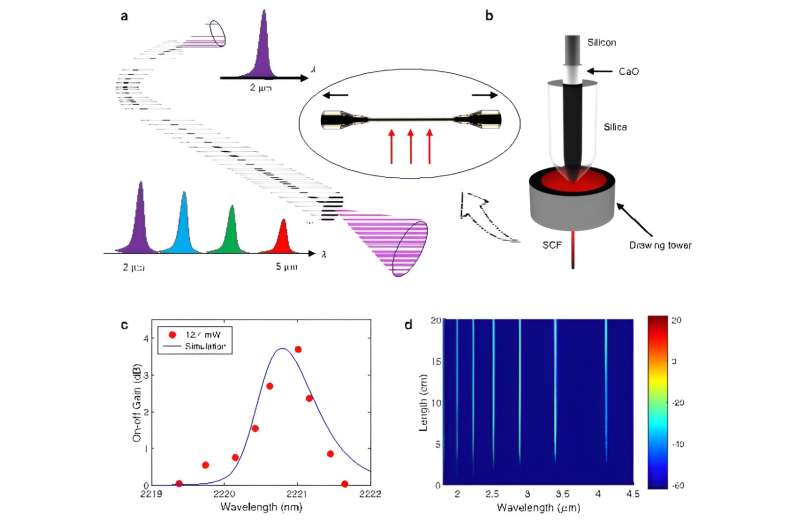This article has been reviewed according to Science X's editorial process and policies. Editors have highlighted the following attributes while ensuring the content's credibility:
fact-checked
peer-reviewed publication
trusted source
proofread
Raman amplification at 2.2 μm in silicon core fibers with prospects for extended mid-infrared source generation

The mid-infrared spectral region has attracted great research interest over the past decade, as it is important for many biomedical and sensing applications. However, there is still a major challenge to develop compact and tunable fiber-based light sources that operate at wavelengths beyond 2 μm.
Raman scattering is a nonlinear process that can be used to generate or amplify optical signals in wavelength regions where traditional light sources are limited or unavailable. Thus, when constructed from high-power lasers and waveguides with broad transmission windows, Raman systems can be used to translate near-infrared pump sources into the mid-infrared to help fill the wavelength gaps in this region.
In a new paper published in Light: Science & Applications, an international research team, led by Professor Anna C. Peacock from Optoelectronics Research Centre, University of Southampton, United Kingdom, have demonstrated high levels of Raman amplification at wavelengths extending beyond 2 μm by making use of a highly nonlinear silicon core fiber (SCF) platform.
Compared to planar silicon systems, SCFs have emerged as an exciting platform for mid-infrared Raman amplification as they offer extended propagation lengths, low propagation losses and efficient coupling to fiber lasers. The SCF used in this work was fabricated by a molten core drawing method, which allows for the rapid production of long lengths of fiber.
The fiber was then post-processed via a tapering procedure, which acts to enhance the nonlinear performance through optimization of the core material and size. The resulting SCF was produced with a transmission loss of only 0.2 dB/cm, with a consistent micrometer-sized tapered waist diameter over a length of 6 cm.
By pumping the optimized SCF with a thulium-doped fiber laser, the team have demonstrated Raman emission and amplification at 2.2 μm. For the case of stimulated Raman amplification, an on-off peak gain of ~30 dB was achieved for a pump power of only ~10 mW, thanks to the large Raman gain coefficient of the crystalline core material.
Importantly, the low losses of the SCF also open a route to extend the reach of the Raman wavelength shifting out to 4 μm and beyond via cascaded processes. This work represents the first demonstration of mid-infrared Raman scattering in any silicon waveguide system—either fiber or chip-based—and thus provides a crucial step towards the development of robust, compact and tunable systems in this spectral band.
More information: Meng Huang et al, Raman amplification at 2.2 μm in silicon core fibers with prospects for extended mid-infrared source generation, Light: Science & Applications (2023). DOI: 10.1038/s41377-023-01250-y
Journal information: Light: Science & Applications
Provided by Chinese Academy of Sciences





















